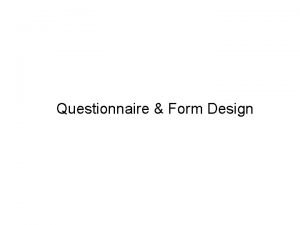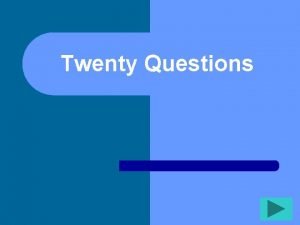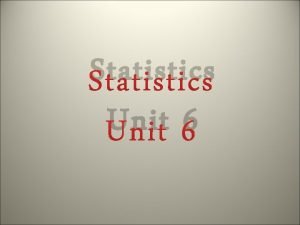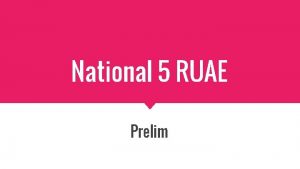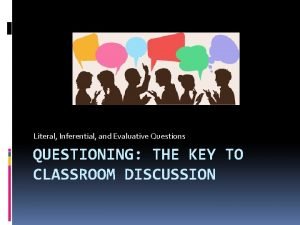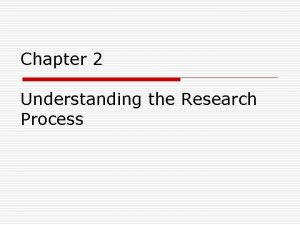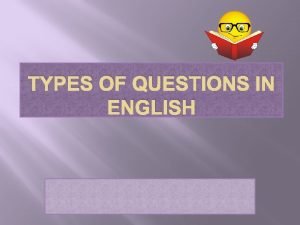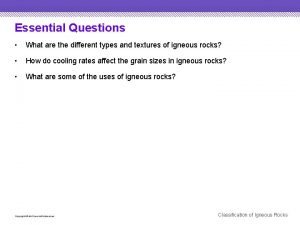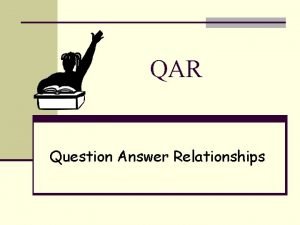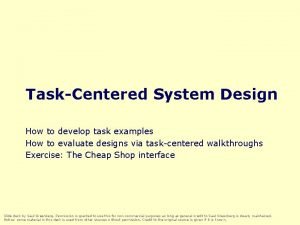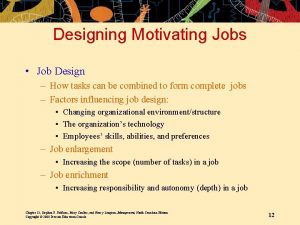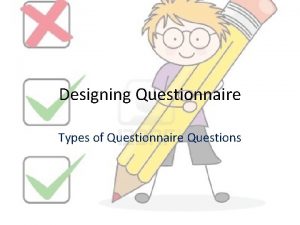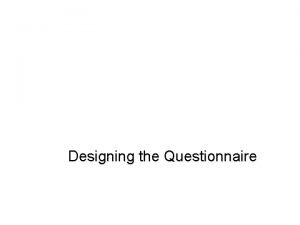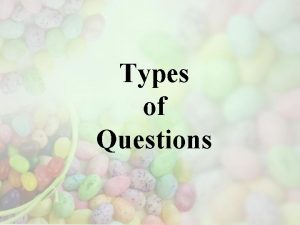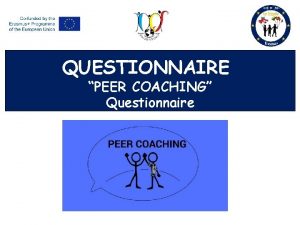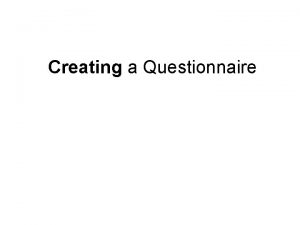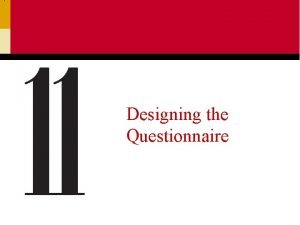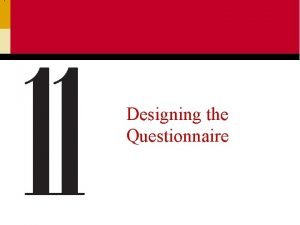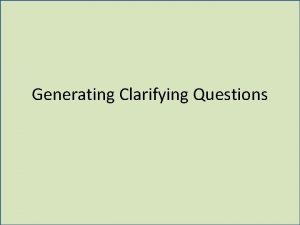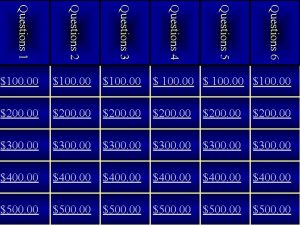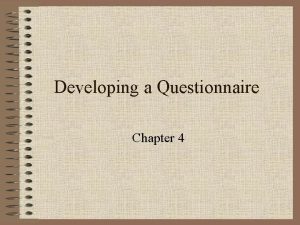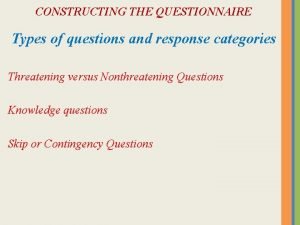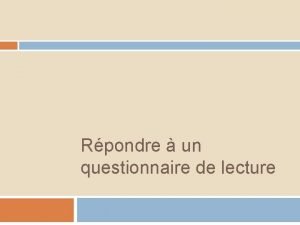Designing Questionnaire Types of Questionnaire Questions Designing Questionnaire





































- Slides: 37

Designing Questionnaire Types of Questionnaire Questions

Designing Questionnaire • TWO (2) types of questions: a) Open-ended questions b) Closed-ended questions

Open- ended Questions • SUBJECTIVE questions. • Require MORE THAN ONE word answers. • Allow someone to give a free form answers using their own knowledge, personal feelings, opinions or ideas about a subject. – What is it like to live in the state of Perlis? – What is your favourite memory from childhood? – What was your high school experience like? • Usually begin with the following words: Why, How, What, Describe, Tell me about…, or What do you think about…

What are the advantages and disadvantages of using open-ended questions?

Advantages of Open-ended Questions 1. Provide rich qualitative data. 2. Provide researcher opportunity to gain insight on all opinions on a topic 3. Highlight responses that researchers or evaluators could not have anticipated.

Disadvantages of Open-ended Questions 1. Take longer time to read through and code. 2. Slow down the reporting process. 3. Hard to make generalization. * Work best in studies with smaller populations.

Types of Open-ended Questions

a) Unstructured : - Why did you choose to study at Uni. MAP? - How can Uni. MAP improve itself to be the best public university in Malaysia? b) Word Association: What is the first thing that comes to mind when you hear the following words: Exam: _______ (nervous, challenging) Concert: ______ ( interesting, boring) c) Sentence Completion: - On the day I arrived at Uni. MAP, I felt. . . - A good student is someone…

Close-ended Questions • OBJECTIVE questions. • Come in a multitude of forms, but are defined by their need to have explicit options for a respondent to select from. • Respondents need to choose from a list of pre-selected options. • ADVANTAGES: – Quick to be answered. – Provide quantifiable data useful for calculating statistical data and percentages. – Allow researchers to categorize respondents into group based on the options they have selected.

Types of Close-ended Questions 1. Dichotomous or two-point questions (Yes or No , Satisfied or Unsatisfied) 2. Multiple-choice questions (e. g. : A, B, C or D) 3. Scaled Questions – – Likert Scale Important questions Three to seven- point scales Semantic Differential

1. Dichotomous Questions • A question which can have two possible answers. • Usually used in a survey that ask for Yes/No, True/False or Agree/Disagree answers. – Please enter your gender: Male / Female – Do you like the new hostel at Uni. MAP Main Campus? Yes / No

2. Multiple- choice questions • Questions with three or more answer options/ choices. • Example: What is your favourite pizza topping? A. Pepperoni B. Mushrooms C. Anchovies D. Sausage

3. Scaled Questions

a. Importance Questions • To assess what is the MOST IMPORTANT to your respondents with rating scale of 1 to 5. • Help you to understand what the respondents like BEST and LEAST about the program or service that you chose. • Measuring the level of importance will garner critical information that allow the service/ program to continue or to be modified. • E. g. :

b. Likert Questions • Help you ascertain how strongly your respondents AGREE or DISAGREE to a series of statements. • Help you assess your respondents feels towards certain issue, product or service.


c. Semantic Differential • The semantic differential scale asks a person to rate a product, brand, or company based upon a seven-point rating scale that has two bipolar adjectives at each end. The following is an example of a semantic differential scale question. Example: Would you say our web site is: (7) Very Attractive (6) (5) (4) (3) (2) (1) Very Unattractive • Notice that unlike the rating scale, the semantic differential scale does not have a neutral or middle selection. A person must choose, to a certain extent, one or the other adjective.

d. Rating Scale Questions • Respondents are asked to RATE a particular issue on a scale that ranges between POOR to GOOD.

PROBLEMATIC QUESTIONS A. Presuming or Leading Questions e. g. : Don’t you think that the bank should open at night for the convenience of clients? Questions that use phrases like “Wouldn’t you say that…” or “Don’t you agree that…” * These phrases may also lead the respondents to prefer a certain choice given.

PROBLEMATIC QUESTIONS B. Questions which rely on memory. e. g. : “How many times did you Whatsapp your friend last week? ” “What were you doing on the night of 24 th December last year? ” * Questions which tax the respondent’s memory too much are likely to lead to inaccurate reply.

PROBLEMATIC QUESTIONS C. Questions requiring prior knowledge. e. g. : “Do you think Uni. MAP’s engineering clean room is the best in Malaysia? ” * For someone who is at Uni. MAP for the first time, they will not know.

PROBLEMATIC QUESTIONS D. Long wordy question. - Questions that have many words. - If the questions are too long and detailed, the respondents may get lost and their responses will relate only the beginning or the end of the question.

PROBLEMATIC QUESTIONS E. Double-barrelled Questions e. g. : Please rate the lecture in terms of its content and presentation. • Don’t ask for multiple information at a time. • Ask for only one piece of information at a time. 1. content 2. presentation

PROBLEMATIC QUESTIONS F. Hypothetical Questions based on SPECULATION and FANTASY. e. g. : If you were the CEO of an ABC organization, what would be the changes that you would bring? If you were given a million dollar….

PROBLEMATIC QUESTIONS G. Sensitive Questions - Personal details (e. g. : age); Health; Personal Habits; Income; etc. - People are likely to give honest replies to personal questions if some rapport has been developed with the interviewer. - It is generally best to keep all questions dealing with demographic (such as age) at the end of the questionnaire.

Questionnaire Format 1. 2. 3. 4. 5. Title Introduction Confidentiality Statement Instruction Questions • • Section A: General Overview Section B: Problems Section C: Solutions Section D: Personal Information

1. Title • State what your survey is about. • E. g. : – A Survey on Proposing to Build a Student’s Mall at Uni. MAP Main Campus. – A Proposal to Build 24 -hours Mini Library at Wang Ulu Hostel

2. Introduction • i. At the beginning of the questionnaire: Indicate WHO you are and WHY you are doing the survey. You should also have a letter to your lecturer or supervisor to authenticate this. ii. (If applicable) indicate how the respondents were selected. iii. Indicate how it is to be answered. iv. How to return the questionnaire (if not being delivered in person.

E. g. : Hello, We are students of UVW 312 - English for Technical Communication and we are doing on a survey about____ in Uni. MAP. In order to complete our survey, we need your help and cooperation. We really appreciate your cooperation for taking part in this survey, so that we can gather information for our report. The questionnaire consists of four sections. Please tick the appropriate answer for each section.

3. Confidentiality Statement • A legal agreement between researcher and the respondents which stating the responses given in the survey is CONFIDENTIAL and should not be released to third parties without your prior consent. • E. g. : - All information given will be treated as confidential. - Whatever the content in this proposal is confidential and is only used in UVW 312’s assignment. - All of the information provided will be treated as completely confidential and it will not be possible for anyone to identify the information that you give us when we write up the project report.

4. Instruction QUESTIONS’ INSTRUCTION. - At the beginning of each part: Ø ensure that each section or question has clear instruction on how to respond/ answer. Ø Indicate the form of the answer expected. e. g. : -Please give your opinion/ answer for the statements by placing a tick (√) in the appropriate box. - Circle the appropriate answer.

5. Questions • Section A : General Overview – Questions for general opinion (SECTION A) should be able to reflect respondents’ overall opinion based on their experience using the service, e. g. how often they use the service, how important is the service to them, are they satisfied users, etc. • Section B: Problems – Questions for problems (SECTION B) should be able to reflect respondents’ opinion and satisfactory level for the problems that they have identified.

5. Questions • Section C: Solutions – Questions for solutions (SECTION C) should be able to reflect respondents’ agreement for the solutions that they have suggested. • Section D: Demographic Profile – Questions for Section D should be able to indicate about the respondents’ background information such as gender, age, level of study, etc.

Question Order • Start with the easiest questions ( usually closeended)

Pilot Study A. Purposes: i. To test how long it takes to complete. ii. To check that the questions are not ambiguous. iii. To check that the instructions are clear. iv. To allow you to eliminate questions that do not produce usable data. v. Ideally it should be piloted on a group similar to the one that will form the population of your study.

Group Activity Please sit in your group to discuss. 5 people per group.

Discussion 1) What is your idea about the program? What will the program be like? 2) What is the duration of the program? When do you plan to have the program? Will the program be organized weekly/monthly/annually? 3) Who will be involved to organize the program? Are you proposing a collaboration with any department/ organization? 4) Who are your target audience for the program? Will the program be made compulsory for the students to attend? Will it be free or not for the students? 5) How do you plan to promote the program? 6) How are you going to get the fund/ budget for the program?
 Designing a questionnaire
Designing a questionnaire Indirect questions with if and whether
Indirect questions with if and whether Researchable and non researchable questions
Researchable and non researchable questions Negative yes no questions examples
Negative yes no questions examples Twenty questions questions
Twenty questions questions Work in pairs and answer the questions.
Work in pairs and answer the questions. Types of statistical questions
Types of statistical questions How to answer in your own words questions national 5
How to answer in your own words questions national 5 Take a look at following pictures and answer
Take a look at following pictures and answer Literal question
Literal question Scope and delimitation example
Scope and delimitation example Types of research
Types of research 5 types of questions in english
5 types of questions in english Types of quantitative research questions
Types of quantitative research questions Question tag rules
Question tag rules Higher biology questions
Higher biology questions Three types of questions
Three types of questions Types of assessment questions
Types of assessment questions Types of essential questions
Types of essential questions Types of essay questions
Types of essay questions Qar question types
Qar question types Task centered approach example
Task centered approach example Designing a message
Designing a message Local area network design
Local area network design Patrick baudisch
Patrick baudisch Rpa clasp
Rpa clasp Marketing environment framework
Marketing environment framework What shapes internal structure
What shapes internal structure The process of designing and maintaining an environment
The process of designing and maintaining an environment Objectives of human resource information system
Objectives of human resource information system Integrated thematic unit
Integrated thematic unit You are designing a sticker to advertise your band
You are designing a sticker to advertise your band Computer aided embroidery
Computer aided embroidery Channel designs
Channel designs Ros smith
Ros smith Designing a pay structure
Designing a pay structure Designing motivating jobs adalah
Designing motivating jobs adalah Designing brand marketing programs
Designing brand marketing programs
